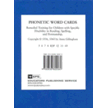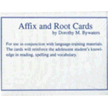What Makes for Effective Orton-Gillingham Programs?
Some programs claim to be Orton-Gillingham programs, but the multisensory activities are missing or light weight. SO, you need to check programs carefully to make sure they’re actually effective Orton-Gillingham programs.
Programs often claim to be Orton-Gillingham based on providing direct and explicit instruction in reading. Those programs are better than whole language learning for children with dyslexia. However, programs that JUST provide direct instruction usually don’t work well for a child with dyslexia.
The programs don’t work well because kids with true dyslexia need multi-sensory, hands-on, and visual programs. Children with “true” dyslexia, or a language-based reading disability, need effective Orton-Gillingham programs, and all effective programs are full of multi-sensory activities.
What to look for in effective Orton-Gillingham programs:
Below are a few things to look for when shopping for effective Orton-Gillingham programs. I’ve put “A” (Auditory), “V” (Visual), “K” (Kinesthetic) and “T” (Tactile) next to each item, so you can see which ones apply to each learning style. I’ll discuss more about learning styles below. For each program you’re considering, ask yourself:
- What types of body-movement activities are in each of the lessons? (K/T)
- Are there both large and small body movements in each lesson? (K)
- Is the sense of touch used with a variety materials (carpet, velvet, sandpaper, etc)? (T)
- How many visual images are in each lesson? (V)
- Are there drawings, images, and 3-D elements like clay work or plastic letters in the lessons? (V)
- Do the lessons only have printed letters with no visuals? (not good) (V)
- Is the child required to speak, recite, or parrot back the concepts being taught in each lesson? (A K)
- Does the teacher speak out loud to ‘teach’ each of the concepts? (A)
A program that uses all of the activities in the list above is a true Orton-Gillingham program. It’s more likely to be one of the effective Orton-Gillingham programs if it has variety in each lesson.
MANY programs include a lot of visual and auditory work. However, few include tactile and kinesthetic activities in every lesson.
Are you Ready to Use an Orton-Gillingham program?
If your child is a tactile or kinesthetic learner, look into Orton-Gillingham training for yourself. Why?
Because Tactile and Kinesthetic learners are not taught well in most learning programs. You will need to come up with a lot of hands-on and movement-based activities to effectively teach your child. If you have O-G training, you’ll know how to add a variety of activities to your child’s lessons. It will be money well spent.
Additionally, your child WON’T get meaningful hands-on, active instruction in most general public school settings. Almost all public school “teaching” takes place through talking and listening. The teaching is great for auditory learners. However, that kind of teaching doesn’t serve most tactile, kinesthetic, and even visual learners very well. 
The success of an Orton-Gillingham program also depends heavily on your child’s unique learning needs. For example, if your child is a visual learner and a particular program is mostly auditory, then your child won’t learn as much from THAT program. Your child will learn more from a program that has a lot of visual activities.
The use of all multi-sensory types (visual, auditory, kinesthetic, and tactile) in teaching helps improve learning for most kids. However, keep in mind, a child has one or two primary learning styles. If you use his primary learning style(s), that usually brings about more learning progress.
So a big key is to match the multisensory teaching in effective Orton-Gillingham programs to your child’s learning style(s).
Ineffective Orton-Gillingham programs:
You may wonder: How can a program be lacking in multi-sensory elements, especially if it claims to be an Orton-Gillingham program?
As an example, think about pushing a computer button. This is not REALLY a useful hands-on activity.. Pushing a button is not like writing a letter with your fingers in a pan of sand or liquid soap. However, almost all computer-based programs based upon Orton-Gillingham methods rely solely on clicking mouse buttons as the kinesthetic or tactile activity.
Having touchpad or touch screen activities gives your child a more meaningful kinesthetic learning activity. So, when you look at computer programs, check out the types of activities they use in the program.
You really have to look at how MUCH and what KIND of multi-sensory activities are built into a program. It will help you figure out which ones are likely to be effective Orton-Gillingham programs.
Claiming to be Orton-Gillingham is like a “seal of approval” in the reading world. Therefore, some reading programs say they are “Orton-Gillingham” whether they truly are or not. You have to watch for sales language and make sure you are getting a true Orton-Gillingham program. 😉
The Key to Finding Effective Orton-Gillingham programs:
The key to finding effective Orton-Gillingham programs is in the number and variety of multi-sensory elements in the program. Success also will depend how much your child “needs” the variety of multi-sensory input. Any Orton-Gillingham program can be good or bad. It all depends on how MUCH multi-sensory teaching is used, how it is used, and whether the program is followed closely or not.
As an example of how to determine if a program meets your needs, you might want to look at my “S.P.I.R.E. Orton-Gillingham Program Review” to see how I assess the content of the program. You can see a wider variety of Orton-Gillingham programs in the Orton Gillingham Reading Programs for Dyslexia – 14 Choices article.
You can also learn more about Multi-sensory instruction and HOW to assess your child’s primary learning style by going through the short tutorial at: Learning Abled Kids’ Multi-sensory Training/ — It is free online and generally takes about 20-30 minutes to go through.
Resources for Use with Effective Orton-Gillingham Programs:

Below, you will find the Orton-Gillingham Manual itself. You can learn a LOT from the manual. You can provide effective Orton-Gillingham programs at home for much less than it will cost you to use a trained provider.
THE “official” manual written by Anna Gillingham:
The manual and cards are all you REALLY need. Other programs can make the process easier by doing all of the planning for you or scripting your work, but that also removes some of the flexibility you might want in tailoring your teaching to your child’s specific needs.
 |
The Gillingham Manual, Eighth Edition (Homeschool Edition) By Anna Gillingham & Bessie W. Stillman / Educators Publishing Service The Orton-Gillingham language program has long been used to instruct children and adults with dyslexia and other learning difficulties. Using visual, auditory, and kinesthetic associations, this phonetics-based guide covers reading and spelling, dictionary use, vowels, consonants, digraphs, diphthongs, word structure, handwriting, and more. Includes an appendix with evaluation tools, lesson plans, and suggested reading; a glossary; and an index. 385 pages, hardcover from Educators Publishing. |
The Gillingham manual is the main source of training for the Orton-Gillingham technique. This multisensory phonics approach is appropriate for children of any age as well as adults. The manual covers teaching methods for reading and spelling. There is information about helping students acquire familiarity with sound symbols (letters and letter combinations), spelling patterns and generalizations, handwriting, and dictionary technique.
Skills the Gillingham Manual helps you teach:
- History of the English language
- Sound-symbol relationships
- Letter formation
- Spelling generalizations
- Dictionary use
- Short and long vowel sounds
- Digraphs
- Diphthongs
- Affixes and roots
- Word structure
- Consonant sounds
- Decoding and encoding words
Word Cards for Use in Effective Orton-Gillingham programs:
 |
Phonetic Word Cards (Homeschool Edition) By Anna Gillingham & Bessie W. Stillman / Educators Publishing ServiceThis case contains 610 cards for use with any Orton-Gillingham based approach to reading instruction. The cards are divided into 43 groups of phonic sounds. Single words and detached syllables are used to exemplify the important patterns and generalizations found in reading and spelling. The cards can be used for decoding practice, to introduce spelling rules and generalizations, or for dictation. They are organized sequentially beginning with CVC words and moving on to spelling generalizations, syllabication, and word structure. One case per student is recommended. |
PHONEME Cards for Use in Effective Orton-Gillingham programs:
 |
Gillingham Phonics Drill Cards (8th Edition, without pictures; Homeschool Edition) By Anna Gillingham & Bessie W. Stillman / Educators Publishing ServiceColor-coded, this set of “Phonics Drill Cards for Reading and Spelling” was designed to accompany the Gillingham Manual approach to reading and spelling. White, yellow, and coral colored cards are intended to impress associations with vowel sounds, presenting a visual stimulus that calls for an oral response. Teachers show the front of the card, which presents either a vowel phonogram (coral cards), consonant phonogram (white cards), or Spelling symbolic representation of a sound (yellow cards). Some blank cards are included. Revised 8th Edition. |
 |
Affix & Root Cards (Homeschool Edition) By Anna Gillingham & Bessie W. Stillman / Educators Publishing ServicePart of the The Gillingham Manual, 8th Edition curriculum, and also used in the EPS Recipe for Reading program, this set of 132 color-coded cards will reinforce your students decoding and vocabulary skills. A prefix, root, or suffix is shown on one side of the card and defined on the back. Green cards show Anglo-Saxon prefixes & suffixes; orange shows Latin prefixes, roots and suffixes; and blue cards show Greek word elements. 132 cards. Please note that this item is available for purchase by Homeschools only. |

